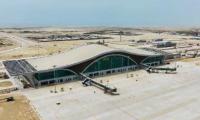villages,” it is stated in the assessment report.
Long-term effects
The phenomenon is not a new one, even in Karachi. The fishing communities of Thatta and Badin have been trying for the past two decades to compel the government to pay a little attention to the loss of their livelihoods and agricultural land.
The issue finally made it to the Senate last week when a standing committee after reviewing this report sent a letter to the prime minister asking him to take concrete steps for mitigating the rapid erosion of the coastal areas.
The research also points out that dredging being carried out by the Port Qasim Authority (PQA) and Karachi Port Trust (KPT) for the past few decades has already caused locations such as the Bundal Island to be submerged by the Arabian Sea.
“The PQA has been dredging since the 1970s to keep the navigational channel open for ship movement. There is no legal policy to protect the nearby areas from erosion and as a consequence of the maintenance of this channel, Bundal and other small islands are being eroded due to the absence of any protection mechanism,” its is written in the report.
Another example given is that of the developing areas around Shireen Jinnah Colony. “In the mid-1990s, the KPT planned to reclaim the area near Shireen Jinnah Colony for real estate purposes and sediments were dredged from the intertidal zone, adjacent to the National Institute of Oceanography. Though the area was reclaimed successfully at that time, but the following year, as a result of deepening the intertidal zone, high-energy waves began attacking the wall protecting the shore, causing frequent inundation of the wall.”
Worst-case scenarios
One does not need to look far from Karachi to gauge the effects of erosion and intrusion by the Arabian Sea. The districts on either side of Karachi - Badin, Thatta and Sujawal on the east and Lasbella and Gwadar to the West - contain more than a few glaring examples of worst-case scenarios.
According to a separate report by Forever Indus, the Arabian Sea has intruded up to 67 kilometres, destroying large swathes of agricultural land in Thatta and Badin districts by turning it saline.
According to the assessment, Badin is currently bearing the brunt of “severe” sea intrusion and erosion while over Thatta and Sujawal face “moderate” erosion.
“According to independent surveys, more than 3.1 million acres of agricultural land has been submerged in Badin, Thatta and Sujawal districts,” said Nasir Panhwar, an environmental expert.
Kharo Chann and Keti Bunder - two old fishing creeks situated side-by-side on the delta in Thatta and Sujawal districts that are categorised in the climate division’s report to be facing “severe” erosion - are almost completely destroyed.
Though no official records exist, but 34 of Keti Bunder’s 48 settlements have been submerged by the Arabian Sea, displacing around 60,000 people, according to the Forever Indus study. Moreover, the current location of the town itself has changed three times during the past five or six decades.
The president of the Pakistan Fisherfolk Forum, Mohammad Ali Shah, claims that the damage goes as far as Kotri, 200 kilometres up the Indus River. “Since the Kotri Barrage was built in 1955, the water flow in the Indus Delta has been too low to push the seawater back and sustain the local ecosystems,” he said. “As a result, the sea water creeps up the river channels, destroying and eating up land and damaging the local ecosystems. For example, the original residents of Keti Bunder were not fishermen but farmers and the Indus Delta used to be famous around the world for the production of red rice.”
Shah explained that as water reserves had been destroyed by salinity and the land was too barren to grow anything, more than 90 percent of the population relied on fishing as their main source of income. However, he added, because of the harsher weather patterns now, even the fish catch had reduced to an extent that it was not enough to sustain the families.
Shah’s experience is corroborated by the national assessment which confirms that a reduction in the flow of freshwater downstream Kotri has resulted in “surge” of seawater inland, causing destruction of agricultural land and “amplification” of erosion in Thatta and Sujawal districts.
In Badin, the destruction of land has been amplified by the building of the Left Bank Outfall Drain (LBOD), whose structure now is being altered by the Sindh Irrigation and Drainage Authority. “The recently-built LBOD system has become a source of erosion and seawater intrusion far inland, especially via the Tidal Link, which connects the drain with the Arabian Sea. It has a devastating impact on the surrounding environment and has badly affected local agriculture due to the backflow of hyper-saline water in drains,” its noted in the assessment report.
Recommendations
The immediate protection measures advised in the assessment report are for five hotspots - Badin, Damb, Keti Bunder, Pasni and Jiwani. They include building a protection wall around Keti Bunder, redesigning the LBOD and its tidal link as well as the fish harbours and breakwater walls in Pasni and Jiwani as soon as possible.
It is also suggested that a national body should be formed to oversee coastal erosion management and similar bodies be set up in each district.
The smaller bodies will work in collusion with the national body and then get the prevention measures incorporated into the district disaster management plans.
This picture taken on January 30, 2023, shows commuters passing through the Empress Market in Pakistan's port city of...
A representational image showing farmers harvesting wheat crops in a field. — AFP/FileISLAMABAD: In a landmark move...
This representational image shows a number plate. — APP/FileThe public should get new security-featured smart cards...
Japanese Consul General Masaru Hattori addresses an event. — Facebook@JapaneseConsulateKarachi/FileThe Gardenia...
Representational image shows personnel of the Pakistan Customs. — Facebook@Pakistan Customs/FilePakistan Customs...
This representational image shows the Pakistan Coast Guard personnel pictured with recovered narcotics....







